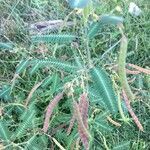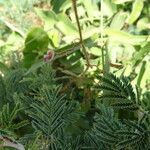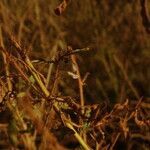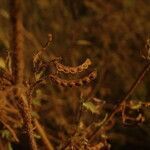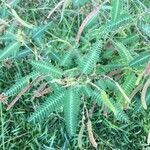Erect subshrubby annual or perennial herb, 0.3-2.5 m tall. Stems mostly slender, c. 5 mm wide at the base but sometimes thick and spongy up to 2.5 cm wide, pubescent with mostly rather sparse tubercular-based sometimes glandular hairs. Leaves sometimes sensitive, 16-50(70)-foliolate; leaflets 3-13 x 1-3 mm, linear-oblong, rounded and mucronulate at the apex, obliquely rounded at the base, entire or very finely serrulate, glabrous; venation obscure; petiole and rhachis together 1.2-10 cm long, with tubercular-based hairs; petiolules 0.3 mm long; stipules 3-15 x 1-3.5 mm, elliptic-lanceolate, straight, spurred, deciduous. Inflorescences leaf-opposed or axillary, 1-6-flowered; peduncle 8-21 mm long; rhachis 1.5-6 cm long; pedicels 1-2 and finally up to 8 mm long; bracts 3.5-6 x 1.5-2.5 mm, mostly ovate, often lacerate or toothed, deciduous; bracteoles 2.5-4.5 x 1-2 mm, ovate-lanceolate to lanceolate, acuminate, ciliolate. Calyx glabrous, 2-lipped; lips 4-6 x 2-3 mm, oblong, one 2-fid, the other 3-fid. Standard yellow or whitish, mostly lined and suffused with red outside or purplish, 7-10 x 4-7 mm, elliptic; wings and keel greenish-white or pale yellow, the petals of the latter not laciniate. Fruit 2.4-4.8 cm long excluding the 6-9 mm stipe, linear, straight or slightly curved, 5-13-jointed, one suture ± straight, the other slightly constricted between the articles; articles 3-5 mm long and wide, oblong, compressed, with sparse short tubercular-based hairs, central part raised and venulose or sometimes rugose, surrounding lower area at length rather coarsely rugose. Seeds dark olive, black or brownish, 2.8 x 2.5 x 1.3-1.8 mm, oblong, slightly beaked near the eccentric small hilum.
Shrublets or annual herbs, (15-)30-100(-150) cm tall. Stems erect, many branched, cylindric, hollow, glabrous, corky at base, often with nodule-bearing adventitious roots. Stipules elliptic to lanceolate, 4-11 × 1-2 cm, membranous, caducous, base auriculate, apex acuminate. Leaves 20-60-foliolate, often sensitive; petiole 2-4 mm; rachis with tuberculate-based trichomes; leaflet blades linear-oblong, 3-13 × 1-3 mm, papery, base oblique, apex obtuse and mucronate. Inflorescences axillary, racemose, sometimes short or reduced to a solitary flower; peduncle 4-7 mm, with tuberculate-based trichomes; bracts ovate, caducous, margin often denticulate. Bracteoles ovate-lanceolate, persistent. Calyx 3-4 mm, membranous, glabrous. Corolla pale yellow with purplish longitudinal striations. Legume linear-oblong, 2.2-3.4 cm × 3-5 mm, straight, herbaceous to leathery, abaxial suture straight, slightly indented; articles 2-8, quadrate, slightly muricate and with tuberculate-based trichomes. Seeds blackish brown, reniform, ca. 2 mm. Fl. Jul-Sep, fr. Jul-Oct. 2n = 40.
An erect annual or perennial plant. It grows in water. It is 1.5-2 m tall. The leaves have an even number of leaflets along the stalk. There are 20 or more pairs. They do not have leaf stalks. They are 3-8 mm long by 1-3 mm wide. The flowers are yellow streaked with orange, brown or purple. They are pea like or like a butterfly. The fruit are narrow pods. They are 3-4 cm long and 3-4 mm wide They break into several one seeded sections.
Leaves sometimes sensitive, 16–50(70)-foliolate; leaflets 3–13 × 1–3 mm, linear-oblong, rounded and mucronulate at the apex, obliquely rounded at the base, entire or very finely serrulate, glabrous; venation obscure; petiole and rhachis together 1.2–10 cm long, with tubercular-based hairs; petiolules 0.3 mm long; stipules 3–15 × 1–3.5 mm, elliptic-lanceolate, straight, spurred, deciduous.
Fruit 2.4–4.8 cm long excluding the 6–9 mm stipe, linear, straight or slightly curved, 5–13-jointed, one suture ± straight, the other slightly constricted between the articles; articles 3–5 mm long and wide, oblong, compressed, with sparse short tubercular-based hairs, central part raised and venulose or sometimes rugose, surrounding lower area at length rather coarsely rugose.
Inflorescences leaf-opposed or axillary, 1–6-flowered; peduncle 8–21 mm long; rhachis 1.5–6 cm long; pedicels 1–2 and finally up to 8 mm long; bracts 3.5–6 × l.5–2.5 mm, mostly ovate, often lacerate or toothed, deciduous; bracteoles 2.5–4.5 × 1–2 mm, ovate-lanceolate to lanceolate, acuminate, ciliolate.
Standard yellow or whitish, mostly lined and suffused with red outside or purplish, 7–10 × 4–7 mm, elliptic; wings and keel greenish-white or pale yellow, the petals of the latter not laciniate.
Erect herb, up to 1.2 m high, drying greenish. Leaves 16-50(-70)-foliolate. Inflorescences leaf-opposed or axillary. Pods with articles strongly tuberculate when adult. Flowers pale yellow.
Stems mostly slender, c. 5 mm wide at the base but sometimes thick and spongy up to 2.5 cm wide, pubescent with mostly rather sparse tubercular-based sometimes glandular hairs.
Seeds dark olive, black or brownish, 2.8 × 2.5 × 1.3–1.8 mm, oblong, slightly beaked near the eccentric small hilum.
Calyx glabrous, 2-lipped; lips 4–6 × 2–3 mm, oblong, one 2-fid, the other 3-fid.
Erect subshrubby annual or perennial herb, 0.3–2.5 m tall.
Pale yellow, faintly striate flowers
An undershrub 2–4 ft. high
